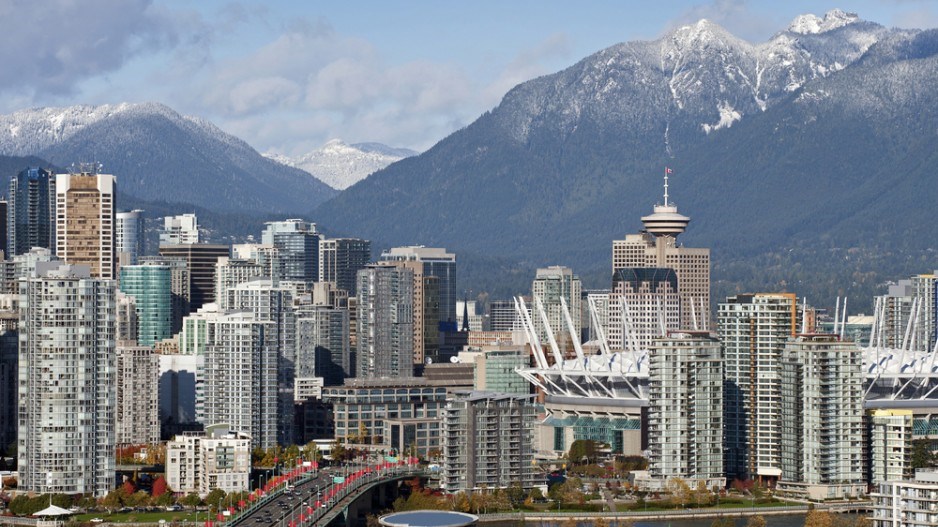Vancouver is in the midst of the biggest boom in office construction in a decade and one of the most dramatic transformations the city has ever seen.
Major office towers, including a few mixed-use developments with significant office components, are emerging across downtown and beyond, even threatening to redefine the idea of where Vancouver’s “downtown” is.
Telus Garden, a million-square-foot development – half residential, half offices – is reimagining the block of Georgia Street between Richards and Seymour.
Underutilized retail spaces and parking lots are giving way to a project that is accelerating the shift of downtown eastward, said Rhiannon Mabberley, project manager for Westbank Projects, the developer that co-owns the project with Telus (TSX:T).
The central library helped open up the area, then residential development in Yaletown and southeast False Creek brought life to the once industrial area. Rogers Arena joined BC Place. The Vancouver Art Gallery is moving in. Now, Mabberley said, Telus Garden is going to be a landmark with a major public presence – and not just because of its size.
“It’s got large cantilevers over the street, it’s got almost a 20,000-square-foot public plaza in the front of it and it’s quite a force on the street,” she said. “In a few years, it’s interesting to think about where downtown will be in your mind.”
The development is also promising to be Canada’s first Leadership in Energy and Environmental Design (LEED) Platinum building. By capturing waste energy and recirculating it to heat the building, Telus Garden will use 80% less power from the grid than a typical building, according to Mabberley.
Andrew Grant, president of PCI Developments, can’t claim to be stretching the bounds of downtown, but Marine Gateway, his mixed-use development at Marine and Cambie, aims to enliven what was once a backwater in south Vancouver. A big factor? Transit. Marine Gateway not only will bring thousands of workers to its 240,000 square feet of office space, but will also be home to hundreds more in its residential division and attract crowds to its transit-adjacent High Street, site of an 11-screen Cineplex theatre complex (available to corporate clients during the day), Loblaws, a pub and liquor store, restaurants, coffee shops, three banks and a Steve Nash Fitness World, adding reasons to get off at Marine Drive station.
Back downtown, in a city that sometimes seems to relish demolition, two other major new projects are integrating historic structures into their plans.
The Exchange, being developed by Credit Suisse (NYSE:CS), is a 31-storey tower incorporating the original 1920s Vancouver Stock Exchange building on Howe Street. With occupancy beginning in 2017, the Exchange just misses out to Telus Garden for the country’s first LEED Platinum designation. Around the corner on West Hastings, the new MNP Tower is rising into the airspace above the historic University and Quadra clubs, next to the Guinness Tower and framing the iconic Marine Building. Architects promise they have maintained the integrity of the historic clubs and the building will enhance rather than dwarf the Marine Building.

A little farther west and also opening this year at 745 Thurlow is 400,000 square feet of space, mostly offices, with three floors of retail and restaurants.
Not new, but newly reconfigured, is the Nordstrom section of Pacific Centre, which will be the headquarters for Sony Pictures Imageworks.
Altogether, these developments represent the biggest growth spurt in a decade, according to Rob Kavanagh, president of the Building Owners and Managers Association of British Columbia. And the boom is a response to pent-up demand.
“Vancouver’s vacancy rate was just gradually diminishing to a point where it was around 4% vacancy downtown, which was giving tenants very few options in which to move,” Kavanagh said. “It’s a welcome phase in the marketplace after a full decade really of no material new development.”
The new buildings offer different floor-plate sizes, expanding options for tenants.
“Vancouver traditionally is a small-tenant market,” he said. “So buildings like MNP Tower cater to the smaller tenants, one tenant per floor. It’s a nice niche. But the flip side of that is there’s not a lot of large floor-plate spaces for tenants that do need a large space on one floor, and Cadillac Fairview at Pacific Centre has kind of gone into that market and has been successful. The other ones are kind of in between.”
In addition to leading-edge environmental standards, the new buildings offer tenants space efficiencies and comforts, raising the bar for the entire office real estate sector.
“The existing buildings have to reinvest in their buildings to remain competitive, so that’s a very good thing. At the end of the day, it breeds competition and it forces people to improve what they have.” •




